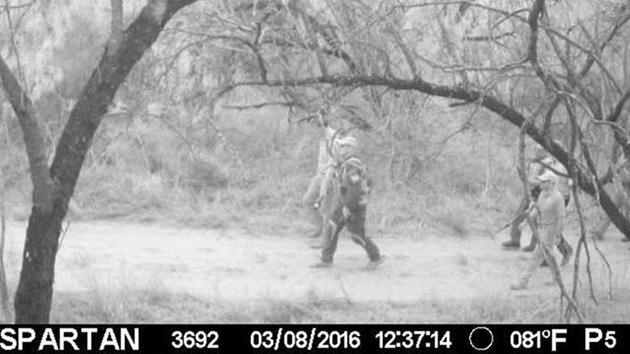Results 1 to 1 of 1
Thread Information
Users Browsing this Thread
There are currently 1 users browsing this thread. (0 members and 1 guests)
-
03-09-2016, 12:49 AM #1
TEXAS LT. GOV: BORDER PLAN WORKING, BUT FEDS AND MEXICO NEED TO DO MORE
By Ted Oberg and Trent Seibert
Tuesday, March 08, 2016 06:53PM
HOUSTON (KTRK) -- In a day-long tour of the Texas-Mexico border near McAllen on Tuesday, abc13's Ted Oberg joined Lt. Gov. Dan Patrick and Texas Department of Safety Director Steve McCraw in an inspection of the border, where Patrick noted gaps in border fencing and suggested that the Mexican government should help pay for the cost of a wall to keep smugglers from the U.S.
This story will be updated throughout the day and there will be more information on the 6pm and 10pm abc13 newscasts.
Oberg started his day with Patrick and McCraw in a helicopter inspection of the border. The copter later landed near the Rio Grande where the DPS showcased three of their river patrol boats, including its newest addition to the fleet, an 'extreme shallow water jet-boat' designed to quickly overtake those smuggling drugs or people over the river.
A team of Texas Rangers also showed off motion-detection surveillance cameras that are lined along the border that can track any movement. If smugglers are picked up on camera, Border Patrol or Department of Public Safety agents are dispatched.
More than 2,300 of these cameras are in use, with 1,338 on the job in the Rio Grande Valley alone, DPS records show.

In this photo, Ted Oberg is picked up on surveillance cameras used to spot smugglers at the border
This border inspection comes as Texas is in the midst of an unprecedented state effort to secure the federal border costing $800 million in state tax dollars.
"We're not going backwards," Patrick said. I'd like to think there's a day when no one will cross the border illegally. We know that won't happen. We want to send a message to cartels that coming into Texas isn't easy. Things have changed dramatically."
The border security program started under Governor Perry and expanded greatly under Gov. Greg Abbott and the lieutenant governor.
State leaders pulled hundreds of troopers into the border region -- including nearly 100 from cities around the state to work here on temporary duty.
Troopers fly helos and planes most days, have boats in the Rio Grande and teams on the ground to spot border-crossers and smugglers. They do not have the legal authority to arrest people solely for illegal entry as that is a federal crime, but claim they are working with the Border Patrol to make that happen.
Judging the success of the effort is tricky.
The program rolled out in the summer of 2014 when a mass of unaccompanied children poured across the border. There was an initial drop in early 2015 after the state and feds ramped up efforts, but levels started rising again in the fall of 2015. January is historically a low, but the rising stats suggest this spring could see spikes that were seen in 2014.
The largest number of unaccompanied children came from El Salvador, records show, with 10,872 making it over the border last year and 8,243 this year. Large numbers of children also come from Guatemala, Honduras and Mexico.
And while the majority of children crossing the border have come from Central America, other have come from Belize, Brazil, Bangladesh, Cuba and Albania, records show.
The DPS brass has always been hard to pin down on how they define success -- at times saying low arrest numbers indicate success, at others suggesting high numbers do and once simply suggesting a massive presence on the border is success in and of itself.
Indeed, Border Patrol records show apprehensions of those crossing the border on a decline. In 2014, there were 341,132 apprehensions of individuals and 61,605 apprehensions of family units crossing the border. Last year that dropped to 221,684 individuals and 32,949 families.
A local rancher who joined Patrick and McCraw said he's seen a marked decrease in people crossing his land.
As for Tuesday, Patrick and McCraw said that safety could be measured in that residents of the towns around the border feel safer now than they did just a year or two ago. And DPS officials said they want to make the border the front line, catching people crossing the border before they can get to a highway or nearby town. Once an illegal crosser gets there, it becomes far more difficult for those individuals to be apprehended,
"We want to put pressure on front line, not 50 miles inland," said Joe Rodriguez, the DPS regional commander." We're trying to say, "Not here in Texas.'"
http://abc13.com/news/lt-gov-border-...-more/1236658/Support our FIGHT AGAINST illegal immigration & Amnesty by joining our E-mail Alerts at https://eepurl.com/cktGTn
Similar Threads
-
John McCain and Jeff Flake Working on Alternate Plan to Address Border Crisis
By Jean in forum illegal immigration News Stories & ReportsReplies: 3Last Post: 07-10-2014, 07:02 PM -
Feds say no plan for fewer agents along U.S.-Mexico border
By FedUpinFarmersBranch in forum illegal immigration News Stories & ReportsReplies: 8Last Post: 10-04-2009, 09:28 PM -
Feds have plan if Mexico drug violence spills over
By crazybird in forum illegal immigration News Stories & ReportsReplies: 16Last Post: 01-13-2009, 03:21 PM -
Feds approve Las Vegas plan for reservoir near Mexico border
By Jean in forum illegal immigration News Stories & ReportsReplies: 1Last Post: 12-14-2006, 04:14 AM -
Arizona, Utah working on border plan
By Brian503a in forum illegal immigration News Stories & ReportsReplies: 0Last Post: 12-01-2005, 11:05 PM


 LinkBack URL
LinkBack URL About LinkBacks
About LinkBacks




 Reply With Quote
Reply With Quote


"YOU WILL FOOT THE BILL FOR ILLEGAL IMMIGRANTS!" GOVERNOR HOCHUL...
04-23-2024, 05:46 AM in Videos about Illegal Immigration, refugee programs, globalism, & socialism